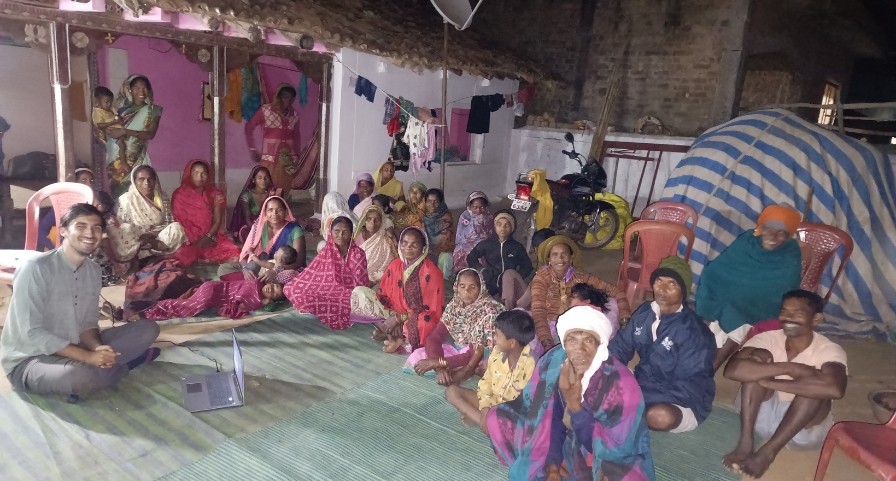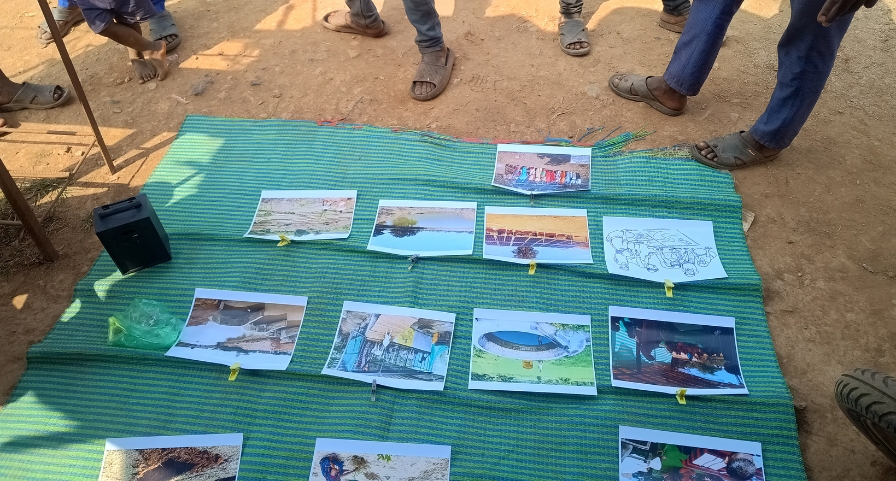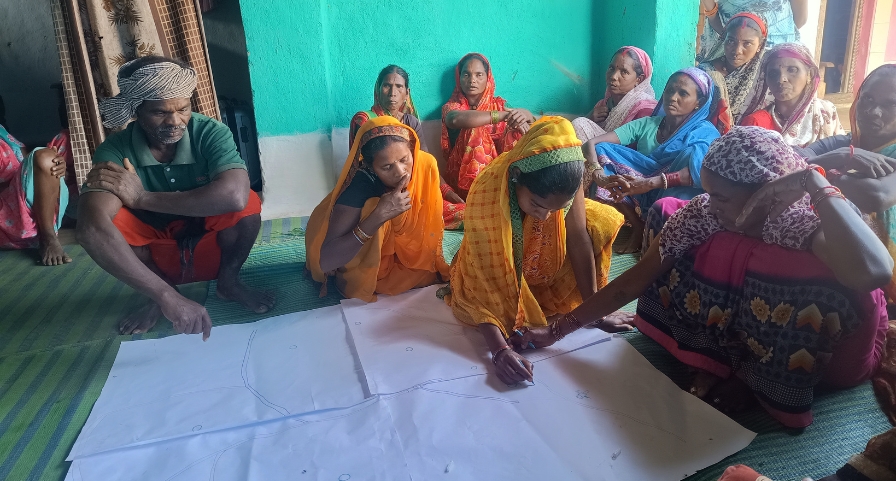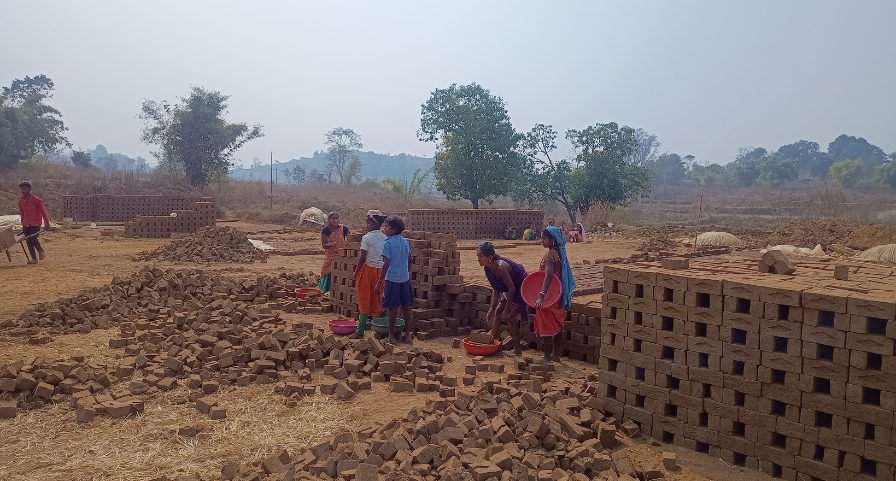While many villages might be entirely poor, poverty is non-homogeneous and differences do exist within the poor. Such gradations of poverty reflect where conditions are worst, making it necessary to focus on poorer and ultra-poor households.
Having engaged in participatory methods in the tribal regions of Madhya Pradesh, here’s how I adapted methodologies to mobilise and seek better participation from poorer and ultra-poor people.
Relatable photos as democratic communication
I try to maximise relatable photos and minimise written words. In tribal contexts, lower literacy and language differences cause communication gaps. Written material excludes the illiterate and speeches can exclude non-Hindi speakers.
People may nod at words they recognise, falsely making me think they understood the whole sentence. To address this, I started using photos. They help in three ways: capturing attention, overcoming literacy/language barriers, and reducing informational burden.

First, relatable photos are fun—people identify locations and events. Secondly, they eliminate the need to explain concepts like ‘check dam.’ Photos let people place them in their own context. Thirdly, photos ease comprehension. Long speeches with complex phrases exclude those who lose track.
These are often the poorer and the ultra-poor, especially women. What’s ‘seen’ is easier to follow because it’s people-driven, not speaker-driven. Thus, photos are more democratic. Oral and written forms are understood only by those fluent in that language, while photos cross these barriers.
Also read: How livelihoods of the poor can be strengthened
On-spot reflection and prior planning for inclusive participation
During participatory activities, it is crucial to not just gather people, but ensure meaningful participation, especially from those who stay silent. Reflection and planning can help engage the poorer and ultra poor.
During a women-led village resource map exercise, I noticed only a few women were drawing. They were the ones from relatively better-off households—better dressed, confident and communicative. The section that remained silent were those who weren’t as well dressed.
Two methods helped: rotating who drew, and constantly asking people sitting far behind to point to resources they accessed. This made the session more lively. Second, I brought extra pens and pencils, so everyone could draw. Just holding a pen made people smile and feel valued.
Rotation and extra stationery enabled others, often poorer, to join. Different methods suit different settings, but the principle remains: nudge silent individuals to speak up. Act with critical observation and plan ahead with resources to ensure inclusive participation.
Mobilise where the ultra-poor have gathered for other purposes
In the tribal villages I work in, households engage in multiple livelihoods. While agriculture is the mainstay during monsoons, post-monsoon, many work in collecting wood, brick making, and MNREGA.

For instance, poorer and ultra-poor people do 10-hour shifts at these kilns and are paid per 1000 bricks by the kiln owners. To seek participation and to mobilise them for development activities like natural resource management planning, it helped to approach them at such worksites.
In a meeting after soon after such mobilisation, many came directly from kilns, increasing turnout from the poorer and poorest households.
It seems helpful to go where people have already gathered for livelihood activities, weekly markets, or festivals. This reaches those who may be left out if mobilisation happens door-to-door.
Also read: She sowed seeds of a grain bank to feed the poor
Making meeting timings work for the ultra-poor
Time choices are critically important for conducting meeting and participatory exercises, and often dictate if the poorer and ultra-poor can meaningfully participate.
I noticed some people often left early during morning and afternoon meetings. Was it my inability to hold attention, or something else? Working with ultra-poor women, the reasons became clear: domestic duties, tending to children, kitchen gardens, and multiple livelihood tasks—from cattle grazing to MNREGA to brick making.
Night meetings, post-dinner, led to much higher participation. Many brick kiln workers, who otherwise would not have, could attend. Afternoon meetings may have ‘large enough’ turnout, but reflection showed who they exclude—the poorer and ultra-poor, for whom time conflicts are starkest.
Using ultra-poor-friendly language
The poorer and ultra poor may often consist of historically excluded ethnic groups, like Particularly Vulnerable Tribal Groups (PVTGs). A consistent field observation has been the inability of Baigas (the PVTGs of the area I work in) to properly understand Hindi, which most other non-Baigas can understand.

The Baiga youth are more comfortable with Hindi due to migration, but women, adults, and older people struggle. This became clear when I stayed in a Baiga hamlet. Communicating was difficult. Visiting non-PVTG areas made this contrast sharper.
Hindi may suffice for the majority, but not for meaningful participation from ultra-poor groups. Community cadres speak local languages, but professionals often don’t. On learning some Chhattisgarhi, I interacted better with Baiga families. Language learning and switching to more friendly languages helped mainstream ultra-poor Baigas into participatory approaches..
Working with those who are last and left behind is difficult, but if special attention and energy are directed towards changing our ways of working, it is possible to include them meaningfully in the development narrative.
Also read: Social audit empowers Odisha’s rural poor
The lead image on top shows members of the Baiga tribe, a Particularly Vulnerable Tribal Group, working at a kiln. Such spots, where poorer and ultra-poor people have already gathered, are valuable for mobilisation. (Photo by Sattava Vasavada Sengupta)
Sattva is a development professional currently working with PRADAN. He loves reading and writing about issues of power, gender and poverty, and tries addressing them through his work as a practitioner.








